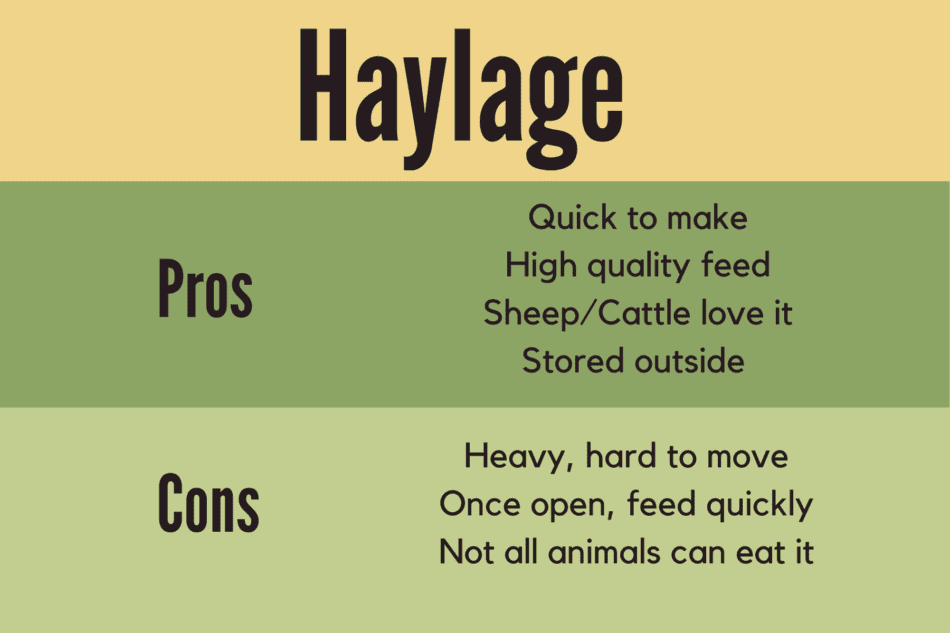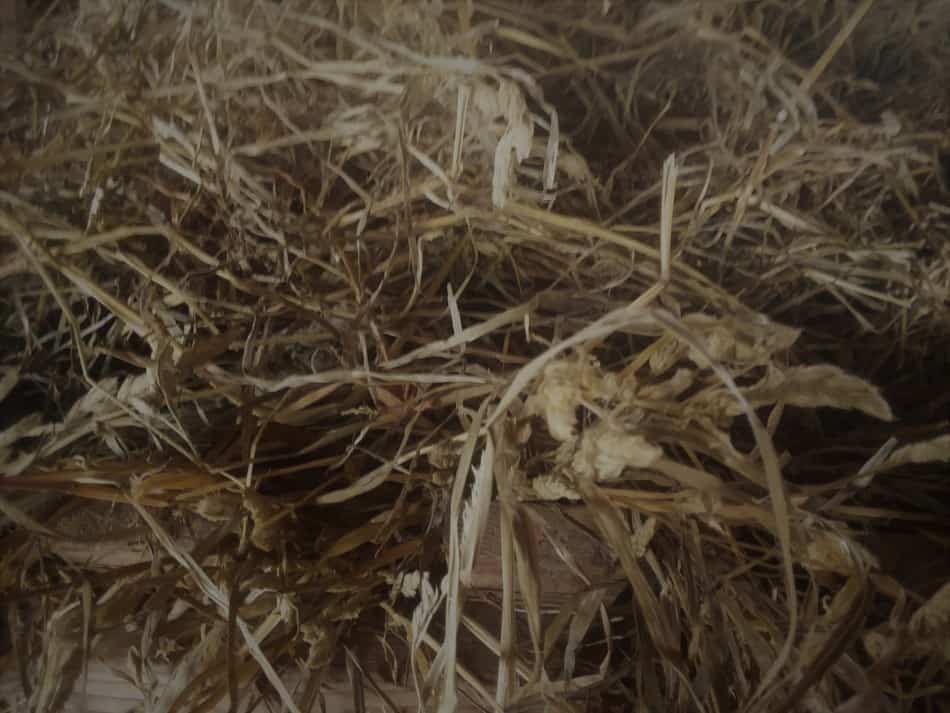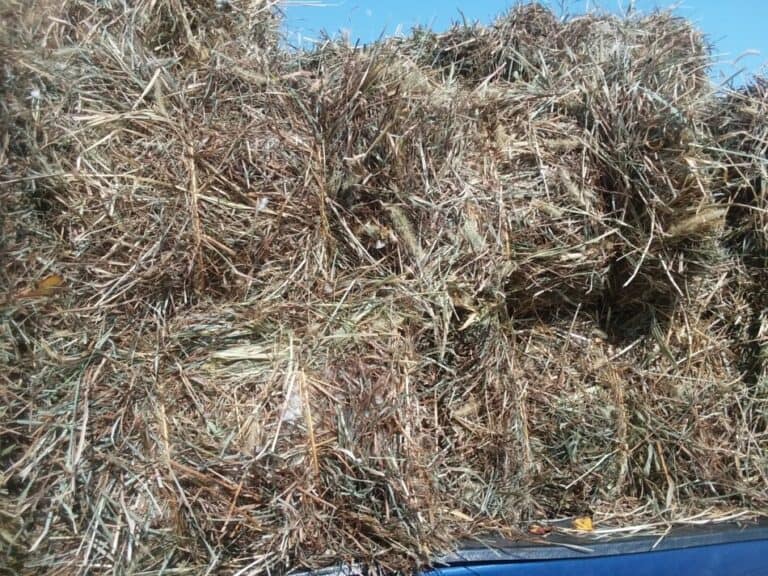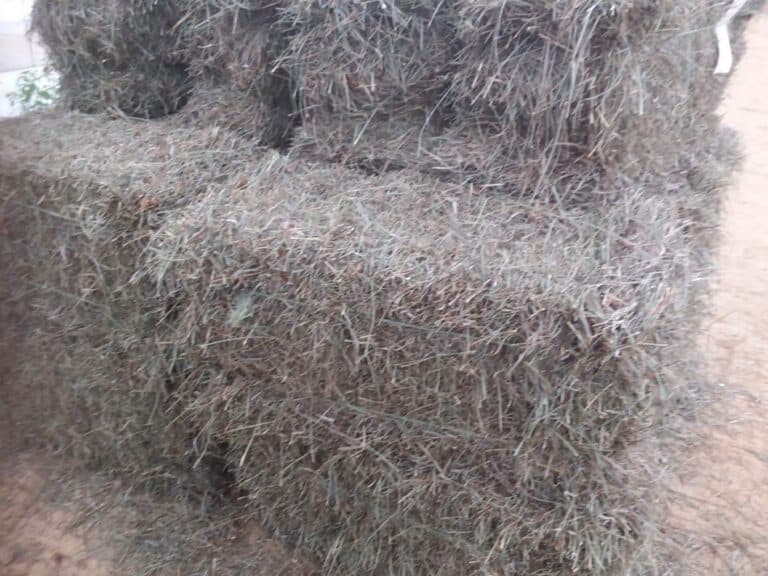Haylage: What It Is And How It’s Made

Haylage is a great alternative to dry hay for both large and small livestock farmers. What exactly is haylage and will it work for you, your farm and your livestock?
Haylage is a 40-60% moisture content hay that is preserved by fermentation.
We have started making our own haylage and are glad we gave it a try! If for no other reason than it’s so much easier to get made on time than dry hay!
In the past, we harvested any extra forage we grew as dry hay and left the haylage making to others.
Why You Should Feed Haylage goes over the reasons why haylage may work really well for you and your livestock.
| Trait | Dry Hay | Haylage |
| Making high quality feed (due to weather problems) | harder | easier |
| Multi species appropriate feed | yes | yes |
| Moisture content | 18-22% | 40-60% |
| Holds well once open | yes | no needs fed in 3-5 days |
| Requires mechanical handling | small bales, no large bales, yes | yes all bales are heavy |
| Requires barn storage | yes | no |
| Ideal for small farmers | yes | yes, in smaller bales no, in bigger bales |
| Waste per bale (twine, netting, plastic) | less, twine or netting | more, plastic and netting |
| Versatile use (made from many forages) | yes | yes |
Haylage is easier to make well than hay
With the weather being wet in the summer lately, we decided to make our own haylage, instead of hoping to catch a dry week.
Since we are primarily pasture based, more rain is better than not enough, but it does make getting hay dry a tough task.
Making great haylage takes less time than making dry hay
By making the decision to harvest our extra forage as haylage instead of dry hay, we have been able to get all of our fields made on time.
In our pre haylage days, getting dry hay made well was tough and, sadly, resulted in our share of rained on hay.
Our summer forage harvesting went well this year, in a season when other farmers in our area that were making dry hay had little to no success.
We count on any hay or haylage we harvest to make a big dent in the amount of purchased forage we need for the winter.
This means it needs to be high quality and harvested on time, both of which have been challenging lately with dry hay for our area.
Haylage is fermented hay
Haylage is forage that is cut, baled moist and wrapped in plastic to ferment.
The forage used for haylage is cut the same as it would be for will for dry hay, the difference is in the timing of baleing.
Haylage is baled at 40-60% moisture, it is essentially a wet bale of wilted forage. Compare that to dry hay, which is 18-22% moisture (University of Missouri).
The wet bale is wrapped in plastic. The plastic cuts off the air, leaving the baled forage in an anaerobic (no air) environment.
Now the naturally occurring bacteria that like to grow in anaerobic conditions start to grow.
This is start of fermentation, which will preserve the forage in a way similat to sauerkraut.
We also make Oatlage, which is a type of haylage made out of, you guessed it-oats.
It is a bit different than this haylage in appearance and our reasons for making it.
For the details, click over to my article on Oatlage.
Haylage is easier to store than dry hay
Haylage has two big advantages over dry hay:
- Ease of storage
- Faster to make than dry hay
Haylage does not need to be in a barn
First off, let’s talk about storage. Haylage is normally stored outside in rows or stacks, no barn is needed.
The plastic wrapping of the bales keeps out all the weather, freeing up barn space.
This is a big deal for us, we don’t have a lot of barn space that is hay friendly and tractor accessible, meaning any hay that we put inside must be able to be moved by hand.
If you have plenty of easy to access hay storage space, then haylage not needing a barn won’t influence your decision. For us, it’s a big help.

Haylage does not move easily
There are a few cautions to be taken here: haylage does not move well and a puncture to the plastic will result in spoilage.
The first is an easy fix, put the haylage where you don’t have to move it. If you must re position the bales you need a grabber.
Don’t use anything that will pierce the plastic.
Torn plastic=spoiling haylage
As for the second concern, punching into the plastic, keep the haylage in a low traffic area and check the plastic every few days.
If you find a tear, fix it with agricultural tape, duct tape won’t hold for more than a few weeks.
Haylage is faster to make, start to finish
If you live in a dry area, then this is not a big deal. Here, shaving some time off the average harvesting window definitely matters
For the eastern half of the U.S., harvesting high quality hay is a challenge.
Ready to bale fields of hay sitting soaking wet for weeks (last year, and the year before) was a normal sight in our area.
Yikes, high stress and low quality results!
To be upfront with you, haylage is not golden. It has timing issues as well.
As far as getting the forage baled at the ideal time to keep peak nutrition for the livestock, haylage is easier than dry hay.
The catch with haylage is that being baled is just step one, it must be wrapped ASAP, no joke.
Waiting to wrap is the potential Achilles heel of haylage.
The good news here is that the timing of the wrapping is completely within your control.
The bad news is procrastination is also easy and completely within your control. The sooner the haylage is wrapped, the better.

Haylage made by baling and wrapping wilted (not dry) hay
At first, making haylage is the same as making dry hay.
You cut the hay field at the highest nutrition growth stage for your stock, usually this is right before blooming or sending up a seed head.
Hopefully, the timing coincides with a window of nice weather!
Once the forage is cut, you watch to see how it is drying down.
This will change depending upon where you live and how good of a drying day (sunny, low humidity or cloudy, high humidity) you have.
Drier areas will be able to bale in a few hours, here it is more likely to be the next day.
Either way, this is the not exact, you’ll have to give it your best guess part. You are looking for somewhere in the really wilted range.
Still looking freshly cut? It needs to dry out more. Looks ready to bale dry? You missed your window. It’s not haylage potential anymore, just bale it dry.
Haylage requires a heavy duty baler
When you decide it is time to bale, be sure you are using a baler that can handle the extra weight of the wetter forages.
A newer baler should be able to work for you without worry. If your baler is older, check into it’s capabilities.
You’ll need two tractors
Most people use two tractors to make haylage.
The first tractor is on the baler and the second is either running the wrapper or tipping the bales up onto the flat side to sit.
A bale sitting on the flat end keeps its round shape, bales left on the round edge will flatten a bit and be harder to wrap, especially if you are individually wrapping them.
Haylage wrappers can be individual or tube
There are two types of wrappers, individual and tube. Both have advantages and ideal use situations.
We did some of each and liked the tube wrapper the best for speed, it’s a ton faster and uses less plastic per bale wrapped.
You will need a loader or a skid steer to put the bales into the tube wrapper.
Once you open a tube of bales there is always an open side to the next bale in line.
The individual wrapper is handy for farms not using the bales very quickly. It takes much longer per bale to individually wrap and uses quite a bit more plastic per bale.
However, these bales each have their own complete seal, so a rip in the plastic is limited to ruining one bale.
Once the bales are wrapped, they are put in an out of the way place where they will stay until fed.
Haylage is fed the same as dry hay
Haylage can be fed in the same way as dry hay. We feed what they need each day, twice a day.
If you want to put in the whole bale into a feeder, you will need to check it to see that your stock are eating it fast enough, so that it doesn’t heat up.
Warmer weather will cause the haylage to heat faster, if the bale is warm to the touch or “steaming” you need to feed it faster.
We roll it out on the fields to the sheep with a bale unroller. Unrolling works well on frozen ground and okay on soft ground.
The weight of the tractor is the issue here, not the unroller. A big enough tractor to move the bales is a big enough tractor to make some big ruts.
Haylage can be fed to stock on pasture
To feed the haylage on pasture, we cut the plastic off, then drive into the field.
Next, we cut the netting and pull it off the bale right before unrolling. Don’t leave the netting out there, they might eat it.
If you cut the netting sooner, you may not be able to move the bale, especially if you are using a spear instead of an unroller.
Cut the netting immediately before unrolling the bale.
Depending upon the day, the flock and the nutritional value of the haylage we may not need to feed the whole bale.
Any leftover bale is taken back out of the field. Don’t leave the unrolled section of the haylage with the sheep or cattle.
They will step on it and poop on it, making it unsuitable to roll out later.
Don’t store haylage in the field with the stock
Please note: it may seem like a good idea to store the wrapped bales in the pasture.
Why move them so far, anyway? This is one of those good idea, bad result things.
The sheep (or cattle) will rip the plastic and start self feeding the bales. The bales must be stored away from the eaters.
Feeding haylage in a barn requires a loader
Haylage can easily be fed in the barn, actually most people would probably be feeding it inside.
You must be able to drive and maneuver the tractor moving the haylage to the feeders/hay ring or you will need to carry haylage by hand.
These bales are heavy, moving them with people power once they are in the barn doesn’t work.
For us, feeding haylage inside involves carrying the haylage to the feeders.
We put the bale in the end of the barn with the tractor, then cut the plastic and remove the netting while inside.
The plastic is cut so that it lays flat on the floor and removed when the haylage is fed.
Haylage can be made as baleage
Many people use the words haylage and baleage interchangeably. Sometimes this is accurate, other times it is not.
Haylage is fermented moist hay. It can be in a bunk silo, a bag or bale form. As long as it is fermented hay, it is hayage.
Baleage means that it is fermented hay specifically in bale form, this is the type that we do for our sheep.
It can be any bale size or shape, the most common shape around here being round baled.
Some people even use squares, both small and large, as baleage.
Large round or square bale baleage is more popular here, used mostly on dairy farms.
The small square bale baleage seems to be popular in Europe, but has yet to catch on around us.
In short, haylage is not always in bale form, baleage is always in bale form. Both are fermented hay made for feeding livestock.
Baleage vs. Haylage by Brad Schick, Nebraska Extension Educator explains more of the differences in terminology if you’d like to dig a little deeper.




